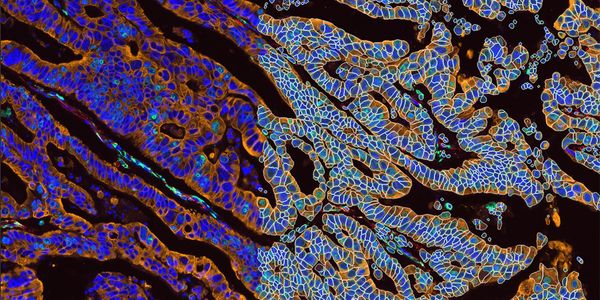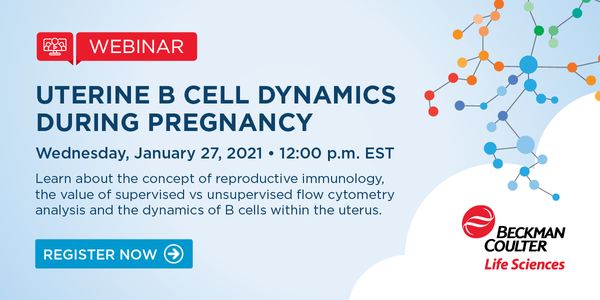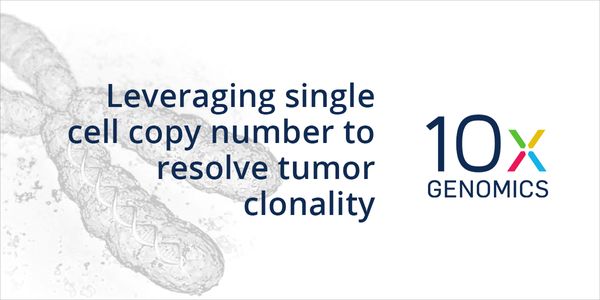Cancer cell clusters
Cancer cell clusters describe groups of cancer cells which clump together and travel throughout the body. Cancer cell clusters are more resistant to actions of the immune system and therapies because they are larger and harder to penetrate than single cells. Metastatic disease can occur when cancer cell clusters move to a distant part of the body and survive long enough to seed into a new cancer.
-
NOV 08, 2023 | 8:00 AMGenerating Insights into tissue microenvironments is crucial to our understanding of normal and abnormal tissue development such as during cancer progression. Spatial biology methods using m...MAR 22, 2023 | 9:00 AMWe have developed 3D-shaped hydrogel microparticle platforms to capture cells, as well as isolate and label their secretions. These “lab on a particle” systems enable sorting cel...OCT 06, 2022 | 7:30 AMSingle-cell RNA sequencing (scRNA-seq) is an important technology that reveals gene expression differences between different cell types. Yet scRNA-seq data can be challenging to analyze and...Speaker: Jean-Noel Billaud, PhDMAY 19, 2022 | 8:00 AMDate: May 19, 2022 Time: 8:00am (PDT), 11:00pm (EDT), 5:00pm (CEST) Mass spectrometry (MS)-based proteomic technologies are increasingly applied in a clinical context for disease classific...OCT 05, 2021 | 7:00 AMDate: October 05, 2021 Time: 7:00am (PDT), 10:00am (EDT) After new users become familiar with flow cytometry instrumentation and learn how to set up the instrument and acquire data, the next...SEP 22, 2021 | 11:59 PMBladder cancer is the 4th most prevalent cancer in men, 11th in women and presents one of the highest rates of post-treatment recurrence (70%) among malignancies. Despite its impact on human...JAN 27, 2021 | 9:00 AMDATE: January 27, 2021 TIME: 9am PST Well-timed interaction of correctly functioning maternal immune cells is essential to facilitate healthy placenta formation, as the uterine immune enviro...OCT 08, 2020 | 6:00 AMEvery patient is different and so is every tumor! The term “personalized oncology” today is largely associated with sequencing approaches. Current publications proof more and mor...Speaker: Christian Regenbrecht, PhDPresented at: Cancer Research & Oncology Week Virtual Event Series 2020
Sponsored By: Luminex - A DiaSorin CompanySEP 23, 2020 | 2:30 PMIntro to high-dimensional data analysis 3:00–3:30 pm PDT Presented By: El-ad David Amir, PhD FAUST: A new interpretable machine learning approach for automated gating 3:30–4:00 p...Speaker: Trevor McKee, PhD , El-ad David Amir, PhD , Raphael Gottardo, PhDPresented at: 9th Annual Fluidigm Mass Cytometry Virtual Summit
SEP 23, 2020 | 10:30 AMSpeaker TBD 10:30–10:50 am PDT Exploring the immune tumor microenvironment of hepatocellular carcinoma with Imaging Mass Cytometry™ 10:50 am–11:10 am PDT Presented By: Won...Speaker: Won Jin Ho, MD , Melissa B. Davis, PhDPresented at: 9th Annual Fluidigm Mass Cytometry Virtual Summit
SEP 23, 2020 | 10:30 AMOn measuring photons and ions: Impact on panel design, signal detection and data quality 10:30–11:00 am PDT Presented By: Tim Bushnell, PhD, MBA Monitoring immunotherapy with a mass cy...Speaker: Tim Bushnell, PhD, MBA , Gerd Haga Bringeland, MD, PhD , Greg Hopkins, BSPresented at: 9th Annual Fluidigm Mass Cytometry Virtual Summit
SEP 16, 2020 | 12:15 PMImage-based high-content screening (HCS) involving cancer cell lines grown in conventional two-dimensional (2D) cell culture, has provided a cornerstone assay for searching new agents to tre...JUN 03, 2020 | 12:00 PMA key step in the clinical production of CAR T cells is the expansion of engineered T cells. To generate enough cells for viable adoptive cell therapy, cells must be robustly stimulated, whi...Speaker: Pratip K. ChattopadhyayMAY 20, 2020 | 1:15 PMBackground: Acute myeloid leukemia (AML) is a molecularly and clinically heterogeneous hematological malignancy. Despite recent advancements in the treatment of AML, approximately 50% of pat...MAY 19, 2020 | 11:45 AMPancreatic ductal adenocarcinoma (PDAC) remains a treatment-refractory disease and existing molecular subtypes do not inform clinical decisions. Previously-identified bulk transcriptomic sub...Speaker: William L. Hwang, MD, PhDPresented at: Advancing Science - A Virtual Oncology Conference
APR 29, 2020 | 6:00 AM...APR 22, 2020 | 9:00 AMSingle-cell RNA sequencing has emerged as an important technology that can reveal gene expression differences between different cell types. This webinar will demonstrate how bioinformatics s...Speaker: Jean-Noel Billaud, PhDNOV 12, 2019 | 10:00 AMDATE: November 12, 2019TIME: 10:00am PSTDirect measurement of copy number by droplet-based shallow sequencing of genomic DNA has the potential to provide new insights into tumor heterog...OCT 03, 2019 | 9:00 AMCRISPR (clustered regularly interspaced short palindromic repeats) RNA and CRISPR-associated genes (Cas) assemble into RNA-guided surveillance complex that targets foreign nucleic acids for d...SEP 10, 2019 | 9:00 AMDATE: September 10, 2019TIME: 9:00am PDTAfter new users become familiar with flow cytometry instrumentation and learn how to set up the instrument and acquire data, the next topic to ma...JUN 20, 2019 | 1:30 PMTumor heterogeneity is a hallmark of cancer and can have significant impact on identifying drivers, including those that may be therapeutically relevant. Although, the traditional sequencing...JUN 20, 2019 | 6:00 AMVirtually all tumors are genetically heterogeneous, containing subclonal populations of cells that are defined by distinct mutations. Subclones can have unique phenotypes that influence disea...MAY 09, 2019 | 12:00 PMScreening to identify all known viruses and other pathogenic microorganisms including bacteria, fungus and parasites in human tumor tissues will provide a more comprehensive understanding of...Speaker: Erle Robertson, PhDMAY 09, 2018 | 12:00 PMIn this presentation I will describe results from a family study designed to identify the genetic cause for familial clustering of several early onset cancers. Data from next generatio...
NOV 08, 2023 | 8:00 AM
Generating Insights into tissue microenvironments is crucial to our understanding of normal and abnormal tissue development such as during cancer progression. Spatial biology methods using m...
MAR 22, 2023 | 9:00 AM
We have developed 3D-shaped hydrogel microparticle platforms to capture cells, as well as isolate and label their secretions. These “lab on a particle” systems enable sorting cel...
OCT 06, 2022 | 7:30 AM
Single-cell RNA sequencing (scRNA-seq) is an important technology that reveals gene expression differences between different cell types. Yet scRNA-seq data can be challenging to analyze and...
Speaker:
Jean-Noel Billaud, PhD
MAY 19, 2022 | 8:00 AM
Date: May 19, 2022 Time: 8:00am (PDT), 11:00pm (EDT), 5:00pm (CEST) Mass spectrometry (MS)-based proteomic technologies are increasingly applied in a clinical context for disease classific...
OCT 05, 2021 | 7:00 AM
Date: October 05, 2021 Time: 7:00am (PDT), 10:00am (EDT) After new users become familiar with flow cytometry instrumentation and learn how to set up the instrument and acquire data, the next...
SEP 22, 2021 | 11:59 PM
Bladder cancer is the 4th most prevalent cancer in men, 11th in women and presents one of the highest rates of post-treatment recurrence (70%) among malignancies. Despite its impact on human...
JAN 27, 2021 | 9:00 AM
DATE: January 27, 2021 TIME: 9am PST Well-timed interaction of correctly functioning maternal immune cells is essential to facilitate healthy placenta formation, as the uterine immune enviro...
OCT 08, 2020 | 6:00 AM
Every patient is different and so is every tumor! The term “personalized oncology” today is largely associated with sequencing approaches. Current publications proof more and mor...
Speaker:
Christian Regenbrecht, PhD
Presented at: Cancer Research & Oncology Week Virtual Event Series 2020
Sponsored By: Luminex - A DiaSorin Company
Sponsored By: Luminex - A DiaSorin Company
SEP 23, 2020 | 2:30 PM
Intro to high-dimensional data analysis 3:00–3:30 pm PDT Presented By: El-ad David Amir, PhD FAUST: A new interpretable machine learning approach for automated gating 3:30–4:00 p...
Speaker:
Trevor McKee, PhD
, El-ad David Amir, PhD
, Raphael Gottardo, PhD
Presented at: 9th Annual Fluidigm Mass Cytometry Virtual Summit
SEP 23, 2020 | 10:30 AM
Speaker TBD 10:30–10:50 am PDT Exploring the immune tumor microenvironment of hepatocellular carcinoma with Imaging Mass Cytometry™ 10:50 am–11:10 am PDT Presented By: Won...
Speaker:
Won Jin Ho, MD
, Melissa B. Davis, PhD
Presented at: 9th Annual Fluidigm Mass Cytometry Virtual Summit
SEP 23, 2020 | 10:30 AM
On measuring photons and ions: Impact on panel design, signal detection and data quality 10:30–11:00 am PDT Presented By: Tim Bushnell, PhD, MBA Monitoring immunotherapy with a mass cy...
Speaker:
Tim Bushnell, PhD, MBA
, Gerd Haga Bringeland, MD, PhD
, Greg Hopkins, BS
Presented at: 9th Annual Fluidigm Mass Cytometry Virtual Summit
SEP 16, 2020 | 12:15 PM
Image-based high-content screening (HCS) involving cancer cell lines grown in conventional two-dimensional (2D) cell culture, has provided a cornerstone assay for searching new agents to tre...
JUN 03, 2020 | 12:00 PM
A key step in the clinical production of CAR T cells is the expansion of engineered T cells. To generate enough cells for viable adoptive cell therapy, cells must be robustly stimulated, whi...
Speaker:
Pratip K. Chattopadhyay
MAY 20, 2020 | 1:15 PM
Background: Acute myeloid leukemia (AML) is a molecularly and clinically heterogeneous hematological malignancy. Despite recent advancements in the treatment of AML, approximately 50% of pat...
MAY 19, 2020 | 11:45 AM
Pancreatic ductal adenocarcinoma (PDAC) remains a treatment-refractory disease and existing molecular subtypes do not inform clinical decisions. Previously-identified bulk transcriptomic sub...
Speaker:
William L. Hwang, MD, PhD
Presented at: Advancing Science - A Virtual Oncology Conference
APR 29, 2020 | 6:00 AM
...
APR 22, 2020 | 9:00 AM
Single-cell RNA sequencing has emerged as an important technology that can reveal gene expression differences between different cell types. This webinar will demonstrate how bioinformatics s...
Speaker:
Jean-Noel Billaud, PhD
NOV 12, 2019 | 10:00 AM
DATE: November 12, 2019TIME: 10:00am PSTDirect measurement of copy number by droplet-based shallow sequencing of genomic DNA has the potential to provide new insights into tumor heterog...
OCT 03, 2019 | 9:00 AM
CRISPR (clustered regularly interspaced short palindromic repeats) RNA and CRISPR-associated genes (Cas) assemble into RNA-guided surveillance complex that targets foreign nucleic acids for d...
SEP 10, 2019 | 9:00 AM
DATE: September 10, 2019TIME: 9:00am PDTAfter new users become familiar with flow cytometry instrumentation and learn how to set up the instrument and acquire data, the next topic to ma...
JUN 20, 2019 | 1:30 PM
Tumor heterogeneity is a hallmark of cancer and can have significant impact on identifying drivers, including those that may be therapeutically relevant. Although, the traditional sequencing...
JUN 20, 2019 | 6:00 AM
Virtually all tumors are genetically heterogeneous, containing subclonal populations of cells that are defined by distinct mutations. Subclones can have unique phenotypes that influence disea...
MAY 09, 2019 | 12:00 PM
Screening to identify all known viruses and other pathogenic microorganisms including bacteria, fungus and parasites in human tumor tissues will provide a more comprehensive understanding of...
Speaker:
Erle Robertson, PhD
MAY 09, 2018 | 12:00 PM
In this presentation I will describe results from a family study designed to identify the genetic cause for familial clustering of several early onset cancers. Data from next generatio...























